
European cuisine
Encyclopedia

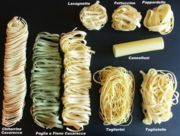
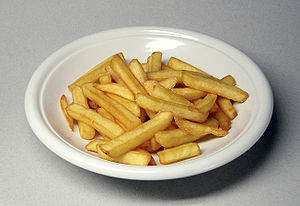
Cuisine
Cuisine is a characteristic style of cooking practices and traditions, often associated with a specific culture. Cuisines are often named after the geographic areas or regions that they originate from...
s of Europe
Europe
Europe is, by convention, one of the world's seven continents. Comprising the westernmost peninsula of Eurasia, Europe is generally 'divided' from Asia to its east by the watershed divides of the Ural and Caucasus Mountains, the Ural River, the Caspian and Black Seas, and the waterways connecting...
and other Western countries
Western world
The Western world, also known as the West and the Occident , is a term referring to the countries of Western Europe , the countries of the Americas, as well all countries of Northern and Central Europe, Australia and New Zealand...
. European cuisine or Western cuisine includes that of Europe
Europe
Europe is, by convention, one of the world's seven continents. Comprising the westernmost peninsula of Eurasia, Europe is generally 'divided' from Asia to its east by the watershed divides of the Ural and Caucasus Mountains, the Ural River, the Caspian and Black Seas, and the waterways connecting...
including (depending on the definition) that of Russia
Russia
Russia or , officially known as both Russia and the Russian Federation , is a country in northern Eurasia. It is a federal semi-presidential republic, comprising 83 federal subjects...
, as well as non-indigenous cuisines of North America
North America
North America is a continent wholly within the Northern Hemisphere and almost wholly within the Western Hemisphere. It is also considered a northern subcontinent of the Americas...
, Australasia
Australasia
Australasia is a region of Oceania comprising Australia, New Zealand, the island of New Guinea, and neighbouring islands in the Pacific Ocean. The term was coined by Charles de Brosses in Histoire des navigations aux terres australes...
, Oceania
Oceania
Oceania is a region centered on the islands of the tropical Pacific Ocean. Conceptions of what constitutes Oceania range from the coral atolls and volcanic islands of the South Pacific to the entire insular region between Asia and the Americas, including Australasia and the Malay Archipelago...
, and Latin America
Latin America
Latin America is a region of the Americas where Romance languages – particularly Spanish and Portuguese, and variably French – are primarily spoken. Latin America has an area of approximately 21,069,500 km² , almost 3.9% of the Earth's surface or 14.1% of its land surface area...
, which derive substantial influence from European settlers in those regions. The term is used by East Asia
East Asia
East Asia or Eastern Asia is a subregion of Asia that can be defined in either geographical or cultural terms...
ns to contrast with Asian styles of cooking. (This is analogous to Westerners referring collectively to the cuisines of East Asian countries as Asian cuisine
Asian cuisine
Asian cuisine styles can be broken down into several tiny regional styles that have roots in the peoples and cultures of those regions. The major types can be roughly defined as East Asian with its origins in Imperial China and now encompassing modern Japan and the Korean peninsula; Southeast Asian...
.) When used by Westerners, the term may sometimes refer more specifically to cuisine in Europe or continental; in this context, a synonym is Continental
Continental Europe
Continental Europe, also referred to as mainland Europe or simply the Continent, is the continent of Europe, explicitly excluding European islands....
cuisine, especially in British English
British English
British English, or English , is the broad term used to distinguish the forms of the English language used in the United Kingdom from forms used elsewhere...
.
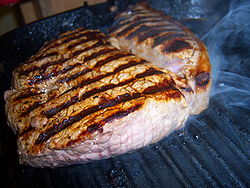
Steak
A steak is a cut of meat . Most are cut perpendicular to the muscle fibers, improving the perceived tenderness of the meat. In North America, steaks are typically served grilled, pan-fried, or broiled. The more tender cuts from the loin and rib are cooked quickly, using dry heat, and served whole...
in particular is a common dish across the West. Similarly to some Asian cuisines, Western cuisines also put substantial emphasis on sauces as condiments, seasonings, or accompaniments (in part due to the difficulty of seasonings penetrating the often larger pieces of meat used in Western cooking). Many dairy products are utilised in the cooking process, except in nouvelle cuisine
Nouvelle Cuisine
Nouvelle cuisine is an approach to cooking and food presentation used in French cuisine. By contrast with cuisine classique, an older form of French haute cuisine, nouvelle cuisine is characterized by lighter, more delicate dishes and an increased emphasis on presentation.-History:The term...
. Wheat
Wheat
Wheat is a cereal grain, originally from the Levant region of the Near East, but now cultivated worldwide. In 2007 world production of wheat was 607 million tons, making it the third most-produced cereal after maize and rice...
-flour bread has long been the most common sources of starch
Starch
Starch or amylum is a carbohydrate consisting of a large number of glucose units joined together by glycosidic bonds. This polysaccharide is produced by all green plants as an energy store...
in this cuisine, along with pasta
Pasta
Pasta is a staple food of traditional Italian cuisine, now of worldwide renown. It takes the form of unleavened dough, made in Italy, mostly of durum wheat , water and sometimes eggs. Pasta comes in a variety of different shapes that serve for both decoration and to act as a carrier for the...
, dumpling
Dumpling
Dumplings are cooked balls of dough. They are based on flour, potatoes or bread, and may include meat, fish, vegetables, or sweets. They may be cooked by boiling, steaming, simmering, frying, or baking. They may have a filling, or there may be other ingredients mixed into the dough. Dumplings may...
s and pastries
Pastry
Pastry is the name given to various kinds of baked products made from ingredients such as flour, sugar, milk, butter, shortening, baking powder and/or eggs. Small cakes, tarts and other sweet baked products are called "pastries."...
, although the potato
Potato
The potato is a starchy, tuberous crop from the perennial Solanum tuberosum of the Solanaceae family . The word potato may refer to the plant itself as well as the edible tuber. In the region of the Andes, there are some other closely related cultivated potato species...
has become a major starch plant in the diet of Europeans and their diaspora since the European colonisation of the Americas. Maize
Maize
Maize known in many English-speaking countries as corn or mielie/mealie, is a grain domesticated by indigenous peoples in Mesoamerica in prehistoric times. The leafy stalk produces ears which contain seeds called kernels. Though technically a grain, maize kernels are used in cooking as a vegetable...
is much less common in most European diets than it is in the Americas
Americas
The Americas, or America , are lands in the Western hemisphere, also known as the New World. In English, the plural form the Americas is often used to refer to the landmasses of North America and South America with their associated islands and regions, while the singular form America is primarily...
; however corn meal, or polenta
Polenta
Polenta is a dish made from boiled cornmeal. The word "polenta" is borrowed from Italian.-Description:Polenta is made with ground yellow or white cornmeal , which can be ground coarsely or finely depending on the region and the texture desired.As it is known today, polenta derives from earlier...
, is a major part of the cuisine of Italy
Italy
Italy , officially the Italian Republic languages]] under the European Charter for Regional or Minority Languages. In each of these, Italy's official name is as follows:;;;;;;;;), is a unitary parliamentary republic in South-Central Europe. To the north it borders France, Switzerland, Austria and...
and the Balkans
Balkans
The Balkans is a geopolitical and cultural region of southeastern Europe...
.
Eastern European cuisines
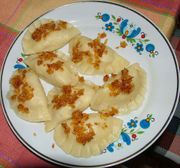
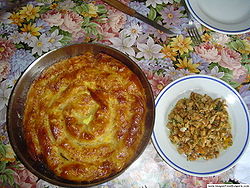
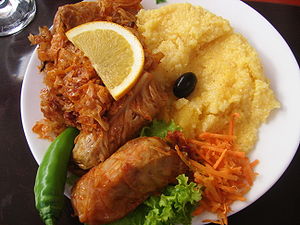
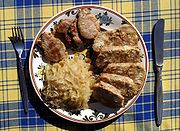
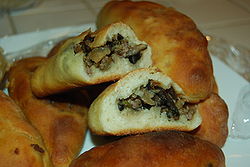

Armenian cuisine
Armenian cuisine includes the foods and cooking techniques of the Armenian people, the Armenian diaspora and traditional Armenian foods and dishes. The cuisine reflects the history and geography where Armenians have lived as well as incorporating outside influences...
Azerbaijani cuisine Belarusian cuisine
Belarusian cuisine
Belarusian cuisine shares the same roots with cuisines of other Eastern and Northern European countries, basing predominantly on meat and various vegetables typical for the region.-History:...
Bulgarian cuisine
Bulgarian cuisine
Bulgarian cuisine is a representative of the cuisine of Southeastern Europe. Essentially South Slavic, it shares characteristics with other Balkans cuisines...
Czech cuisine
Czech cuisine
Czech cuisine has both influenced and been influenced by the cuisines of surrounding countries. Many of the fine cakes and pastries that are popular in Central Europe originated in the Czech lands. Czech cuisine is marked by a strong emphasis on meat dishes. Pork is quite common, and beef and...
Georgian cuisine Hungarian cuisine Moldovan cuisine Polish cuisine
Polish cuisine
Polish cuisine is a style of cooking and food preparation originating from Poland. It has evolved over the centuries due to historical circumstances. Polish national cuisine shares some similarities with other Central European and Eastern European traditions as well as French and Italian...
Romanian cuisine
Romanian cuisine
Romanian cuisine is a diverse blend of different dishes from several traditions with which it has come into contact, but it also maintains its own character...
Russian cuisine
Russian cuisine
Russian cuisine is diverse, as Russia is the largest country in the world. Russian cuisine derives its varied character from the vast and multi-cultural expanse of Russia. Its foundations were laid by the peasant food of the rural population in an often harsh climate, with a combination of...
-
-
 Tatarstan Tatar cuisineTatar cuisineThe Tatar cuisine is primarily the cuisine of the Volga Tatars, who live in Tatarstan, Russia, and surrounding areas.- History :The cuisine of the Volga Tatars takes its origin from the cuisine of the Volga Bulgars, who once were nomads, but nearly 1500 years ego turned to agriculture and...
Tatarstan Tatar cuisineTatar cuisineThe Tatar cuisine is primarily the cuisine of the Volga Tatars, who live in Tatarstan, Russia, and surrounding areas.- History :The cuisine of the Volga Tatars takes its origin from the cuisine of the Volga Bulgars, who once were nomads, but nearly 1500 years ego turned to agriculture and...
Slovak cuisineSlovak cuisineSlovak cuisine varies slightly, though sometimes dramatically, from region to region. It was influenced by the traditional cuisine of its neighbours and it influenced these as well...
Slovenian cuisineSlovenian cuisineThere is no such thing as a single, uniform, distinct Slovenian cuisine. In the opinion of some experts, there are more than 40 distinct cuisines in a country, whose main distinguishing feature is a great variety and diversity of land formation, climate, wind movements, humidity, terrain and...
Ukrainian cuisineUkrainian cuisineUkrainian cuisine has significant diversity, historical traditions. "Cuisine - Flavors and Colors of Ukrainian Culture."] . Accessed July 2011. Common foods used include meats, vegetables, mushrooms, fruits, berries and herbs... -
 Crimea Crimean Tatar cuisineCrimean Tatar cuisineThe Crimean Tatar cuisine is primarily the cuisine of the Crimean Tatars, who live on the Crimean Peninsula in Ukraine.Crimean Tatars have lived on the Black Sea peninsula of Crimea at least since the 13th century...
Crimea Crimean Tatar cuisineCrimean Tatar cuisineThe Crimean Tatar cuisine is primarily the cuisine of the Crimean Tatars, who live on the Crimean Peninsula in Ukraine.Crimean Tatars have lived on the Black Sea peninsula of Crimea at least since the 13th century...
-
Northern European cuisines
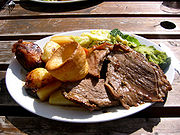

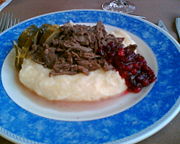
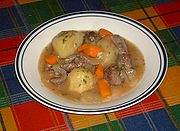
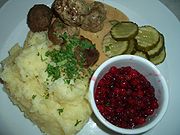


British cuisine
English cuisine encompasses the cooking styles, traditions and recipes associated with England. It has distinctive attributes of its own, but also shares much with wider British cuisine, largely due to the importation of ingredients and ideas from places such as North America, China, and India...
-
-
 Kingdom of England English cuisine
Kingdom of England English cuisine
- Anglo-Indian cuisineAnglo-Indian cuisineAnglo-Indian cuisine is the often distinct cuisine of the Anglo-Indian community in both Britain and India, as well as in America and Australia....
- Anglo-Indian cuisine
-
 Kingdom of Scotland Scottish cuisineScottish cuisineScottish cuisine is the specific set of cooking traditions and practices associated with Scotland. It has distinctive attributes and recipes of its own, but shares much with wider European cuisine as a result of foreign and local influences both ancient and modern...
Kingdom of Scotland Scottish cuisineScottish cuisineScottish cuisine is the specific set of cooking traditions and practices associated with Scotland. It has distinctive attributes and recipes of its own, but shares much with wider European cuisine as a result of foreign and local influences both ancient and modern... -
 Wales Welsh cuisineWelsh cuisineWelsh cuisine is the cuisine of Wales. It has influenced, and been influenced by, other British cuisine. Beef and dairy cattle are raised widely. Sheep farming is extensive in the country and lamb is the meat traditionally associated with Welsh cooking, particularly in dishes such as roast lamb...
Wales Welsh cuisineWelsh cuisineWelsh cuisine is the cuisine of Wales. It has influenced, and been influenced by, other British cuisine. Beef and dairy cattle are raised widely. Sheep farming is extensive in the country and lamb is the meat traditionally associated with Welsh cooking, particularly in dishes such as roast lamb...
Danish cuisine Estonian cuisine Finnish cuisine Icelandic cuisineIcelandic cuisineImportant parts of Icelandic cuisine are lamb, dairy, and fish, due to Iceland's proximity to the ocean. Popular foods in Iceland include skyr, hangikjöt , kleinur, laufabrauð and bollur...
Irish cuisineIrish cuisineIrish cuisine is a style of cooking originating from Ireland or developed by Irish people. It evolved from centuries of social and political change. The cuisine takes its influence from the crops grown and animals farmed in its temperate climate. The introduction of the potato in the second half of...
Lappish cuisine Latvian cuisine Lithuanian cuisineLithuanian cuisineLithuanian cuisine features the products suited to the cool and moist northern climate of Lithuania: barley, potatoes, rye, beets, greens, berries, and mushrooms are locally grown, and dairy products are one of its specialities...
Norwegian cuisine Swedish cuisine
-
Southern European cuisines
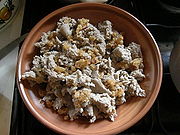

.jpg)
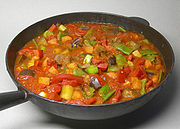
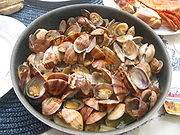
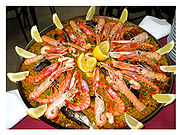
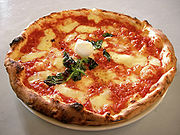
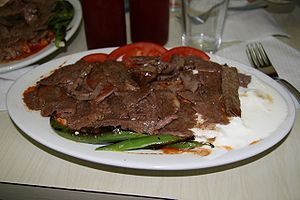
Bosnian cuisine
Bosnian cuisine is balanced between Western and Eastern influences. The food is closely related to Turkish, Middle Eastern and other Mediterranean cuisines. However, due to years of Austrian rule, there are also many culinary influences from Central Europe....
Croatian cuisine
Croatian cuisine
Croatian cuisine is heterogeneous and is known as the cuisine of regions, since every region has its own distinct culinary traditions. Its modern roots date back to ancient periods and the differences in the selection of foodstuffs and forms of cooking are most notable between those on the mainland...
Cypriot cuisine
Cypriot cuisine
Cypriot cuisine is the cuisine of Cyprus and can be described as a blend of Greek cuisines. Greek Cypriot cuisine is another regional Greek cuisine along with Cretan, Ionian, or Attic....
Gibraltarian cuisine
Gibraltarian cuisine
Gibraltarian cuisine is the result of a long relationship between the Andalucian Spaniards and the British, as well as the many foreigners who made Gibraltar their home over the past three centuries. The culinary influences include those from Malta, Genoa, Portugal, Andalusia and Britain...
Greek cuisine
-
- Macedonian Greek cuisineMacedonian cuisine (Greek)Macedonian cuisine is the cuisine of the region of Macedonia. Contemporary Macedonian cooking shares much with general Greek and wider Balkan and Mediterranean cuisine, including dishes from the Ottoman tradition. Some dishes date from ancient Greek days...
Italian cuisineItalian cuisineItalian cuisine has developed through centuries of social and political changes, with roots as far back as the 4th century BCE. Italian cuisine in itself takes heavy influences, including Etruscan, ancient Greek, ancient Roman, Byzantine, Jewish and Arab cuisines... -
 Campania Neapolitan cuisineNeapolitan cuisineNeapolitan cuisine has ancient historical roots that date back to the Greco-Roman period, which was enriched over the centuries by the influence of the different cultures that controlled Naples and its kingdoms, such as that of Aragon and France...
Campania Neapolitan cuisineNeapolitan cuisineNeapolitan cuisine has ancient historical roots that date back to the Greco-Roman period, which was enriched over the centuries by the influence of the different cultures that controlled Naples and its kingdoms, such as that of Aragon and France... -
 Kingdom of Sardinia Sardinian cuisine
Kingdom of Sardinia Sardinian cuisine -
 Sicily Sicilian cuisine
Sicily Sicilian cuisine -
 Tuscany Tuscan cuisine
Tuscany Tuscan cuisine -
 Veneto Venetian cuisineVenetian cuisineVenetian cuisine has a centuries-long history, and it is significantly different from the other cuisines of North Italy as well as neighbouring Austria and Slavic countries, despite having something in common with all these.- Overview :Venetian cuisine may be divided into three main kinds of...
Veneto Venetian cuisineVenetian cuisineVenetian cuisine has a centuries-long history, and it is significantly different from the other cuisines of North Italy as well as neighbouring Austria and Slavic countries, despite having something in common with all these.- Overview :Venetian cuisine may be divided into three main kinds of...
Macedonian cuisine Maltese cuisineMaltese cuisineMaltese cuisine refers to the dishes identified as Maltese. Reflecting Maltese history, it shows strong Sicilian and English influences as well as influences of Spanish, Maghrebin and Provençal cuisines.-History:...
Montenegrin cuisineMontenegrin cuisineMontenegrin cuisine is a result of Montenegro's geographic position and its long history.- Review :The traditional dishes of Montenegro's heartland and its Adriatic coast have a distinctively Italian flavour which shows in the bread-making style, the way meat is cured and dried, cheesemaking, wine...
Portuguese cuisinePortuguese cuisinePortuguese cuisine is characterised by rich, filling and full-flavored dishes and is closely related to Mediterranean cuisine. The influence of Portugal's former colonial possessions is also notable, especially in the wide variety of spices used. These spices include piri piri and black pepper, as...
Serbian cuisineSerbian cuisineSerbian cuisine is a heterogeneous cuisine, sharing characteristics of the Balkans , the Mediterranean , Turkish, and Central European cuisines....
Slovenian cuisineSlovenian cuisineThere is no such thing as a single, uniform, distinct Slovenian cuisine. In the opinion of some experts, there are more than 40 distinct cuisines in a country, whose main distinguishing feature is a great variety and diversity of land formation, climate, wind movements, humidity, terrain and...
Spanish cuisineSpanish cuisineSpanish cuisine consists of a variety of dishes, which stem from differences in geography, culture and climate. It is heavily influenced by seafood available from the waters that surround the country, and reflects the country's deep maritime roots... -
 Andalusia Andalusian cuisineAndalusian cuisineAndalusian cuisine is rather varied, corresponding to a region that is itself extensive and varied. Notwithstanding that, the cuisine of Andalusia is characterized by gazpacho, fried fish , the jamones of Jabugo, Valle de los Pedroches and Trevélez, and the wines of Jerez, particularly...
Andalusia Andalusian cuisineAndalusian cuisineAndalusian cuisine is rather varied, corresponding to a region that is itself extensive and varied. Notwithstanding that, the cuisine of Andalusia is characterized by gazpacho, fried fish , the jamones of Jabugo, Valle de los Pedroches and Trevélez, and the wines of Jerez, particularly... -
 Asturias Asturian cuisineAsturian cuisineAsturian cuisine refers to the typical dishes and ingredients found in the cuisine of the Asturias region of Spain.Asturias is especially known for its seafood, such as fresh squid, crab, shrimp and sea bass...
Asturias Asturian cuisineAsturian cuisineAsturian cuisine refers to the typical dishes and ingredients found in the cuisine of the Asturias region of Spain.Asturias is especially known for its seafood, such as fresh squid, crab, shrimp and sea bass... -
 Aragon Aragonese cuisineAragonese cuisineAragonese cuisine refers to the typical dishes and ingredients of cuisine in the Aragon region of Spain. These include roast lamb ; ham from Teruel; olive oil from Empeltre and Arbequina; a local taste for unusual vegetables as borages and sweet varieties of onion as well as wines from Cariñena,...
Aragon Aragonese cuisineAragonese cuisineAragonese cuisine refers to the typical dishes and ingredients of cuisine in the Aragon region of Spain. These include roast lamb ; ham from Teruel; olive oil from Empeltre and Arbequina; a local taste for unusual vegetables as borages and sweet varieties of onion as well as wines from Cariñena,... -
 Balearic Islands Balearic cuisineBalearic cuisineBalearic cuisine is a Mediterranean cuisine as cooked in the Balearic Islands, Spain. It can be regarded as part of a wider Catalan cuisine, since it shares many dishes and ingredients with Catalonia and the Valencian Community. Others view it as part of a more global Spanish cuisine. Traditional...
Balearic Islands Balearic cuisineBalearic cuisineBalearic cuisine is a Mediterranean cuisine as cooked in the Balearic Islands, Spain. It can be regarded as part of a wider Catalan cuisine, since it shares many dishes and ingredients with Catalonia and the Valencian Community. Others view it as part of a more global Spanish cuisine. Traditional... -
 Basque Country (autonomous community) Basque cuisineBasque cuisineBasque cuisine, the cuisine of the Basque people, includes meats and fish grilled over hot coals, marmitako and lamb stews, cod, Tolosa bean dishes, paprikas from Lekeitio, pintxos , Idiazabal sheep's cheese, txakoli sparkling wine, and Basque cider.A basquaise is a type of dish prepared in the...
Basque Country (autonomous community) Basque cuisineBasque cuisineBasque cuisine, the cuisine of the Basque people, includes meats and fish grilled over hot coals, marmitako and lamb stews, cod, Tolosa bean dishes, paprikas from Lekeitio, pintxos , Idiazabal sheep's cheese, txakoli sparkling wine, and Basque cider.A basquaise is a type of dish prepared in the... -
 Canary Islands Canarian cuisineCanarian cuisineCanarian cuisine refers to the typical dishes and ingredients in the cuisine of the Canary Islands. These include plentiful fish, generally roasted, papas arrugadas , mojos , and wine from the malvasia grape....
Canary Islands Canarian cuisineCanarian cuisineCanarian cuisine refers to the typical dishes and ingredients in the cuisine of the Canary Islands. These include plentiful fish, generally roasted, papas arrugadas , mojos , and wine from the malvasia grape.... -
 Cantabria Cantabrian cuisineCantabrian cuisineCantabria has a variety of foodstuffs, including freshwater and sea fish and seafood, fruit and vegetables, and beef.-Fish and seafood:Seafood is widely used, from the entire coast and the Bay of Santander in particular, including clams, mussels, murgas, cockles, crabs, barnacles, crayfish, snails,...
Cantabria Cantabrian cuisineCantabrian cuisineCantabria has a variety of foodstuffs, including freshwater and sea fish and seafood, fruit and vegetables, and beef.-Fish and seafood:Seafood is widely used, from the entire coast and the Bay of Santander in particular, including clams, mussels, murgas, cockles, crabs, barnacles, crayfish, snails,... -
 Castile-La Mancha Castilian-Manchego cuisineCastilian-Manchego cuisineCastilian-Manchego cuisine refers to the typical dishes and ingredients in the cuisine of Castile-La Mancha region of Spain. These include pisto , gazpacho manchego, the famous queso manchego , the white wine of La Mancha, and the red wine from Valdepeñas.The dishes and specialties of the region...
Castile-La Mancha Castilian-Manchego cuisineCastilian-Manchego cuisineCastilian-Manchego cuisine refers to the typical dishes and ingredients in the cuisine of Castile-La Mancha region of Spain. These include pisto , gazpacho manchego, the famous queso manchego , the white wine of La Mancha, and the red wine from Valdepeñas.The dishes and specialties of the region... -
 Catalonia
Catalonia  Andorra Catalan cuisineCatalan cuisineCatalan cuisine is a Mediterranean cuisine from Catalonia. It may also refer to the shared cuisine of Roussillon and Andorra, which has a similar cuisine to the Alt Urgell and Cerdanya comarques, often referred to as "Catalan mountain cuisine"...
Andorra Catalan cuisineCatalan cuisineCatalan cuisine is a Mediterranean cuisine from Catalonia. It may also refer to the shared cuisine of Roussillon and Andorra, which has a similar cuisine to the Alt Urgell and Cerdanya comarques, often referred to as "Catalan mountain cuisine"... -
 Extremadura Extremaduran cuisineExtremaduran cuisineExtremadura, Spain is known for the different ways of preparing the Iberian pork and the mutton. The main characteristics of the traditional Extremaduran cuisine were its simplicity, its lack of clutter and its low cost. It is also a cuisine reflecting a generous spirit, for many of its...
Extremadura Extremaduran cuisineExtremaduran cuisineExtremadura, Spain is known for the different ways of preparing the Iberian pork and the mutton. The main characteristics of the traditional Extremaduran cuisine were its simplicity, its lack of clutter and its low cost. It is also a cuisine reflecting a generous spirit, for many of its... -
 Galicia (Iberian peninsula) Galician cuisineGalician cuisineGalician cuisine refers to the typical dishes and ingredients found in the cuisine of the autonomous community of Galicia, Spain. These include shellfish, empanadas, polbo á feira , the cheese queixo de tetilla, the ribeiro and albariño wines and orujo liquor.The potato is a staple food in the...
Galicia (Iberian peninsula) Galician cuisineGalician cuisineGalician cuisine refers to the typical dishes and ingredients found in the cuisine of the autonomous community of Galicia, Spain. These include shellfish, empanadas, polbo á feira , the cheese queixo de tetilla, the ribeiro and albariño wines and orujo liquor.The potato is a staple food in the... -
 León, Spain Leonese cuisineLeonese cuisineCastilian-Leonese cuisine refers to the typical dishes and ingredients of the region of Castile and León in Spain. This cuisine is known for its cooked dishes and its grilled or roasted meats , its high-quality wines, the variety of its desserts, its sausages , and its cheeses...
León, Spain Leonese cuisineLeonese cuisineCastilian-Leonese cuisine refers to the typical dishes and ingredients of the region of Castile and León in Spain. This cuisine is known for its cooked dishes and its grilled or roasted meats , its high-quality wines, the variety of its desserts, its sausages , and its cheeses... -
 Valencian Community Valencian cuisineValencian cuisinethumb|250px|[[Coca |Coques de Mullador]], or ratatouille cocas.Valencian cuisine is a Mediterranean cuisine as cooked in the Valencian Community, Spain. Its basic ingredients are vegetables, seafood and meat. It is famous worldwide for its rices, such as paella, and its citrus fruits...
Valencian Community Valencian cuisineValencian cuisinethumb|250px|[[Coca |Coques de Mullador]], or ratatouille cocas.Valencian cuisine is a Mediterranean cuisine as cooked in the Valencian Community, Spain. Its basic ingredients are vegetables, seafood and meat. It is famous worldwide for its rices, such as paella, and its citrus fruits...
Turkish cuisineTurkish cuisineTurkish cuisine is largely the heritage of Ottoman cuisine, which can be described as a fusion and refinement of Central Asian, Middle Eastern and Balkan cuisines. Turkish cuisine has in turn influenced those and other neighbouring cuisines, including that of western Europe...
- Macedonian Greek cuisine
Western European cuisines

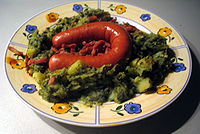

Belgian cuisine
Belgium has been called a nation of gourmands rather than gourmets: a country, in other words, where "big cuisine" comes before "fine cuisine". It has been said that Belgium serves food of French quality in German quantities.-Frieten or frites:...
Dutch cuisine
Dutch cuisine
Dutch cuisine is shaped by the practice of fishing and farming, including the cultivation of the soil for raising crops and the raising of domesticated animals, and the history of the Netherlands.-History:...
French cuisine
French cuisine
French cuisine is a style of food preparation originating from France that has developed from centuries of social change. In the Middle Ages, Guillaume Tirel , a court chef, authored Le Viandier, one of the earliest recipe collections of Medieval France...
-
- Haute cuisineHaute cuisineHaute cuisine or grande cuisine was characterised by French cuisine in elaborate preparations and presentations served in small and numerous courses that were produced by large and hierarchical staffs at the grand restaurants and hotels of Europe.The 17th century chef and writer La Varenne...
- Cuisine classiqueCuisine classiqueCuisine classique is a style of French cookery based on the works of Auguste Escoffier. These were simplifications and refinements of the early work of Antoine Carême, Jules Gouffé and Urbain François Dubois. It was practised in the grand restaurants and hotels of Europe and elsewhere for much of...
- Nouvelle cuisineNouvelle CuisineNouvelle cuisine is an approach to cooking and food presentation used in French cuisine. By contrast with cuisine classique, an older form of French haute cuisine, nouvelle cuisine is characterized by lighter, more delicate dishes and an increased emphasis on presentation.-History:The term...
German cuisineGerman cuisineGerman cuisine is a style of cooking derived from the nation of Germany. It has evolved as a national cuisine through centuries of social and political change with variations from region to region. The southern regions of Germany, including Bavaria and neighbouring Swabia, share many dishes....
Luxembourgian cuisineLuxembourgian cuisineLuxembourg cuisine reflects Luxembourg's position between the Latin and Germanic worlds, drawing on the cuisines of neighbouring France, Belgium and Germany. More recently, it has been influenced by the country's many Italian and Portuguese immigrants...
Swiss cuisineSwiss cuisineSwiss cuisine bears witness to many regional influences, including from Italian, French, and German cuisine, and also features many dishes specific to Switzerland...
- Cuisine classique
- Haute cuisine

